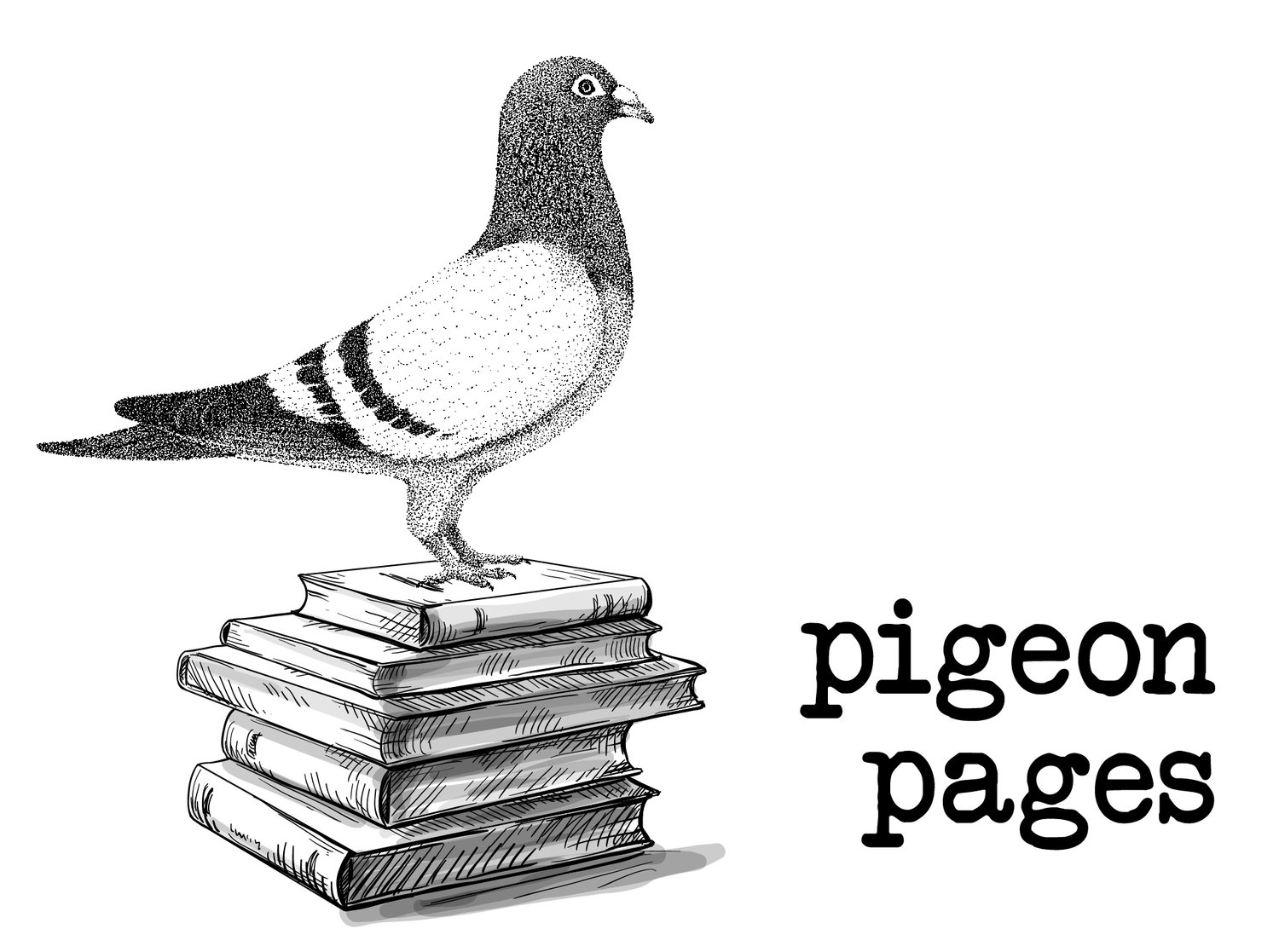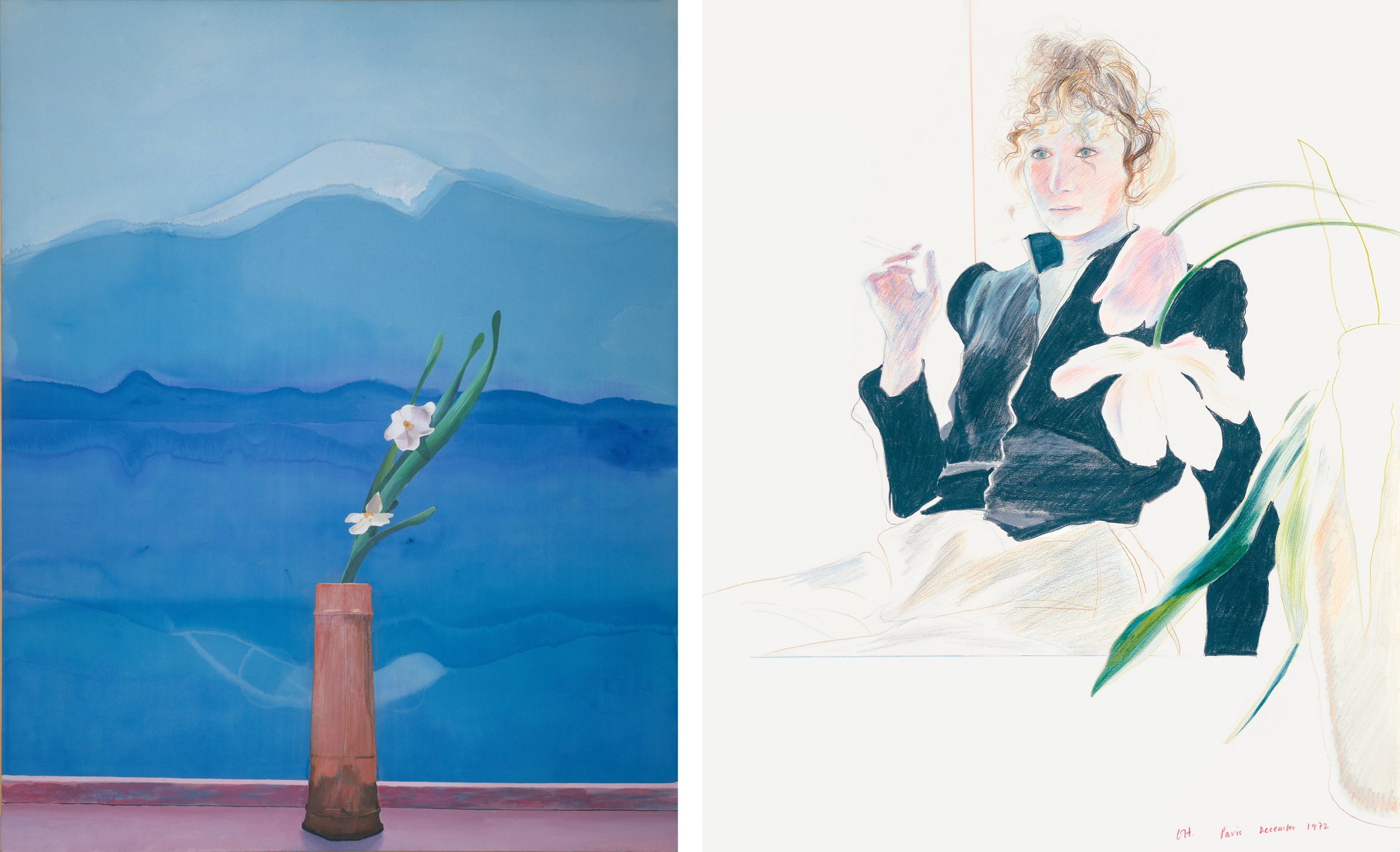Left: David Hockney. Mount Fuji and Flowers, 1972. The Metropolitan Museum of Art, Purchase, Mrs. Arthur Hays Sulzberger. Right: David Hockney. Celia in a Black Dress with White Flowers, 1972. Collection of Victor Constantiner, New York.
The Orange Tank Top
by Sara Petersen
Small white flowers dance across an expanse of orange cotton. Ripe tangerines.
The filmy tank top stretches across Maggie’s body, which has matured almost overnight. Like magic. Thin grass-stem straps travel up Maggie’s shoulders, lazily meeting across her after-school-dancer back, rippling into the divot between her shoulder blades, which seem poised for flight. She wears the tank top with brazen grace, proud of tight, taut breasts. Newly sprung.
The other girl gazes hungrily at the tank top as she follows Maggie down the hallway, which is both cavernous and claustrophobic in that peculiar way of high school architecture. You know the other girl. She is the girl who feels awkward standing alone without leaning against something. She is most comfortable folded into herself, and she moves as quietly as she can, so as not to create any ripples on the undulating surface of a perilous adolescent existence.
She follows in Maggie’s wake towards the tedium of equations and x factors and bilateral angles that have nothing to do with anything that matters to a fourteen-year-old girl. She craves a different sort of understanding, something to do with the orange tank top. She wants to take a bite of Maggie’s juicy knowledge; she wants to stroke Maggie’s downy skin so she can understand what her own is supposed to feel like.
Peaches, cherries, plums. Soft-fleshed fruits easily pierced.
The other girl carries tampons in her backpack as assurance that she’s normal, not because she needs them. She listens to Maggie chatter about how hot Gavin Rossdale is and she nods and says totally but she’s never heard a single Bush song and she thinks looking at pictures of grown up men is boring. Blowjobs sound like urban legends and she feels more heat and heart flush when Maggie uses the phrase “best friend.”
The other girl looks down at her boxy T-shirt, which meets nothing to push back against, its journey from chin to hips smooth and undisturbed. The fabric falls blankly across her flat little-girl chest like a bleak curtain, putting an end to something that is late to begin. She wants to feel something clinging to curves she doesn’t have.
Maggie is racing away from childhood, and the other girl feels herself pulled along in Maggie’s effortless wake. When an explosion of male voices goes off as they approach the chemistry lab, the other girl flinches. Maggie tosses a smile over her head toward a trio of boys across the hall. She laughs so everyone hears her.
The other girl wonders if an orange tank top of her own could transform her ordinariness into something else.
David Hockney. Portrait of an Artist (Pool with Two Figures), 1972. The Lewis Collection.
Later, when they are thirty-four, not fourteen, when the other girl’s boobs have shrunk back to their prepubescent state after being sucked dry by two babies, she will look down at herself, see the way her ethically-sourced cotton T-shirt skips over her almost inverted chest and pushes back against her stomach, which is soft with beer and wine and childbearing and the last few bites of her children’s mac and cheese, scraped off the bottom of the pan.
Her children are napping. The other girl piles vegetables into a bowl for a healthy lunch. She cares about the way she looks—even if no one else does. She wants to zone out in front of her computer. She browses Madewell sales, minimizes an email inbox full of things she is avoiding. She adds V-neck tees and high-waisted skinny jeans meant to look vintage to her online shopping cart, which she leaves floating in limbo.
The other girl is happy. Or at least, she knows she should be happy. She has ticked off so many boxes. Wife. Mother. But she misses being wanted in urgent, non-matrimonial ways. In dreams, Maggie stalks away with the other girl’s college boyfriend laughing laughing smiling laughing.
The other girl scrolls her index finger across the matte, silver square of her laptop’s keypad, zooming in and zooming out, examining Maggie’s body, framed in a neat Instagram square. What is it about her body that holds such power? The other girl is stronger now, she likes the person she’s become. She tells herself that she is no longer susceptible to her adolescent insecurity. But still she thinks about Maggie. Thinks about her body.
She’s traded the orange tank top for a black string bikini. Simple. Minimalist. Easy. Maggie stretches herself against a sunset on a beach, limbs yoga strong, toes pointing into the sky, hands gripping the earth. Her skin, colored by the other girl’s longing or maybe a rosy filter, still seems ripe, ready.
The other girl stares at the screen. She reopens the Madewell tab, types “black bikini” in the search bar. Maybe it will help.
Published January 7th, 2018
Sara Petersen's writing has appeared or is forthcoming from The Rumpus, Vol.1 Brooklyn, Catapult, Hippocampus, Brain, Child, Entropy, The Washington Post, and elsewhere. She is working on a collection of essays about coming to terms with the life she always wanted. You can find her on Twitter @slouisepetersen.
David Hockney (b. 1937) is a British painter, draftsman, printmaker, stage designer and photographer. An important contributor to several art movements across his 60-year oeuvre, a retrospective of the artist is on view at The Met Fifth Avenue in New York City through February 25, 2018.


